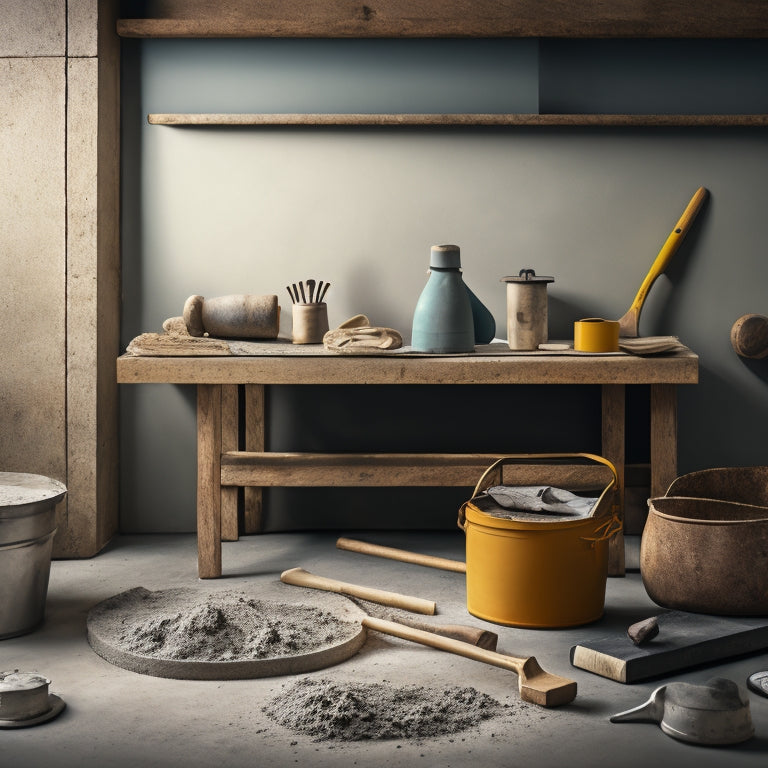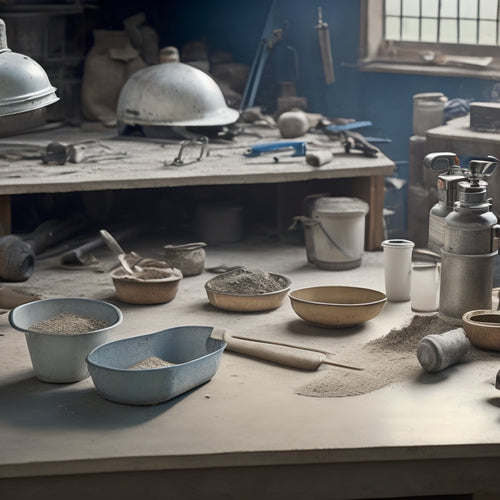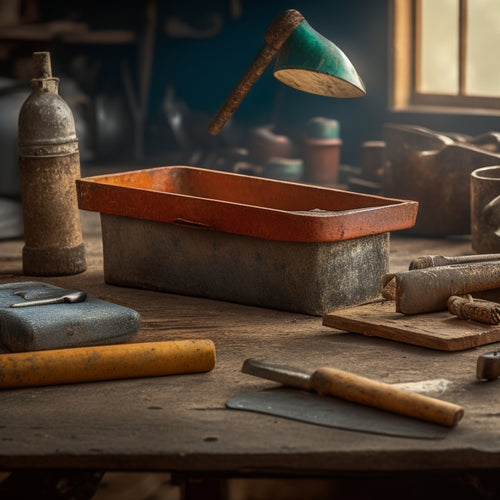
7 Essential Tips for Picking Interior Concrete Tools
Share
When picking interior concrete tools, you'll need to define your concrete grinding needs by identifying surface imperfections, desired finishes, and concrete types. Next, consider tool power, speed, and torque, evaluating electric and pneumatic options and variable speed control. Choose the right abrasive type based on desired finishes and project requirements. Don't forget to check the tool's dust control, ergonomics, and handling features, as well as the brand's reputation and reviews. Finally, assess additional features and costs, including warranties, maintenance, and training. By following these steps, you'll be well on your way to selecting the perfect tools for your project, and understanding the nuances that will make all the difference.
Key Takeaways
• Define your concrete grinding needs by identifying surface imperfections, desired finish, and concrete type to choose the right tools and equipment.
• Select the right abrasive type based on desired surface finish, concrete hardness, and tool speed and pressure for optimal results.
• Ensure dust control and safety by choosing tools with built-in dust collection systems, air filtration, and sealed designs to minimize dust escape.
• Evaluate tool ergonomics and handling by considering comfort, grip design, balance, and weight to reduce operator fatigue and improve control.
• Research brand reputation, product quality, and customer support to ensure you're investing in reliable and durable tools that meet your project needs.
Define Your Concrete Grinding Needs
What specific concrete surface imperfections do you need to correct or prepare for further treatment, and what level of finish are you trying to achieve?
Defining your concrete grinding needs is essential in selecting the right interior concrete tools. In grinding applications, you may need to address cracks, unevenness, or old coatings that require removal. You might be looking to achieve a high-gloss finish, a matte finish, or something in between.
Surface preparation is a vital step in ensuring a successful outcome. You must identify the type of concrete you're working with, its age, and its condition.
Are there any cracks or joints that need to be filled? Are there any existing coatings or adhesives that need to be removed?
Understanding your concrete surface imperfections and desired finish will help you determine the necessary grit sequence, tooling, and equipment required for your project.
Consider Tool Power and Speed
When selecting interior concrete tools, you'll need to evaluate the power and speed requirements for your specific project.
You'll have to decide between electric and pneumatic tools, each with their own advantages and limitations.
As you weigh your options, think about the importance of variable speed control, torque, and horsepower in achieving the desired finish and efficiency.
Electric Vs. Pneumatic
You'll need to contemplate the power and speed requirements of your project when deciding between electric and pneumatic interior concrete tools.
Electric tools offer several advantages, including higher torque and consistent power output, making them ideal for heavy-duty applications. They're also generally quieter and produce less vibration, reducing operator fatigue. Electric tools are also more environmentally friendly, producing zero emissions.
On the other hand, pneumatic tools have their own benefits, such as being lighter and more portable, making them perfect for smaller tasks or working in tight spaces. Pneumatic tools also tend to be more cost-effective and require less maintenance compared to electric tools. Additionally, they can be used in explosive environments, where electric tools may pose a safety risk.
When choosing between electric and pneumatic tools, consider the specific demands of your project and the environment you'll be working in. By weighing the electric advantages and pneumatic benefits, you can select the right tool for the job, ensuring peak performance and efficiency.
Variable Speed Options
With variable speed options, you can fine-tune your interior concrete tool's performance to match the specific demands of your project, ensuring ideal power and speed for efficient results. This feature allows you to adapt to different materials, applications, and work environments, making it an essential factor when selecting a tool.
The variable speed benefits are numerous, including increased precision, reduced wear and tear, and improved overall performance.
When evaluating variable speed options, look for tools with multiple speed settings that can be easily adjusted. This will enable you to tailor the tool's performance to the specific task at hand.
For instance, a lower speed setting may be suitable for delicate or precise work, while a higher speed setting may be necessary for heavier or more demanding applications. By having control over the tool's speed, you can optimize its performance, reduce fatigue, and achieve professional-grade results.
Be sure to weigh the variable speed settings and benefits when choosing an interior concrete tool, as it can make a significant difference in your project's outcome.
Torque and Horsepower
Determining the ideal balance of torque and horsepower is essential, as it directly affects the interior concrete tool's ability to efficiently complete tasks, from light polishing to heavy grinding. You need to evaluate the power and speed requirements for your specific tasks to guarantee you're getting the right tool for the job.
When assessing torque and horsepower, keep the following in mind:
-
Torque ratings: Look for tools with high torque ratings for heavy-duty tasks like grinding and breaking, but be aware that high torque can also lead to increased vibration and reduced control.
-
Horsepower impact: Higher horsepower tools will generally provide faster material removal, but may also increase the risk of overheating and reduce tool lifespan.
-
Speed control: Evaluate tools with variable speed control to adjust to different tasks and materials, ensuring peak performance and reducing the risk of damage.
- Task-specific tools: Choose tools designed for specific tasks, as they're often fine-tuned for the required torque and horsepower, guaranteeing efficient and effective performance.
Choose the Right Abrasive Type
Selecting the correct abrasive type for your interior concrete project is essential, as it directly impacts the efficiency and quality of the finishing process.
You'll need to take into account the desired surface finish, as different abrasive types produce distinct results. For example, if you're aiming for a high-gloss finish, you'll want to use a diamond abrasive, which provides an extremely fine cut. On the other hand, if you're looking for a more textured finish, a metal-bond or resin-bond abrasive might be a better choice.
When choosing an abrasive type, it's also important to take into account the concrete's hardness and the tool's aggressiveness. Softer abrasives, like silicon carbide, are suitable for softer concrete, while harder abrasives, like alumina, are better suited for harder concrete.
Additionally, you'll want to think about the tool's speed and pressure, as these factors can affect the abrasive's performance. By selecting the right abrasive type for your project, you'll achieve the desired surface finish and guarantee a successful outcome.
Check the Tool's Dust Control
You must guarantee your interior concrete tools are equipped with an effective dust control system, as improper dust management can lead to a hazardous working environment and compromised finishing results.
When selecting a tool, evaluate its dust control features to ascertain they meet your needs.
Here are some key aspects to contemplate:
-
Dust collection: Look for tools with built-in dust collection systems or those that can be easily connected to a vacuum or dust extractor.
-
Air filtration: Ascertain the tool's air filtration system is capable of capturing 99.97% of particles as small as 0.3 microns to minimize airborne dust.
-
Sealed systems: Opt for tools with sealed systems to prevent dust from escaping and contaminating the air.
- Easy cleaning: Choose tools with easy-to-clean designs to minimize dust accumulation and reduce maintenance time.
Evaluate Ergonomics and Handling
With a reliable dust control system in place, it's now important to reflect on how comfortably and efficiently you can operate your interior concrete tool, which is where ergonomics and handling come into play.
You'll want to evaluate the tool's design and features that promote comfortable handling and minimize fatigue. Look for a handle that provides ideal comfort and support, allowing you to maintain control and precision throughout the project.
A well-designed grip is essential, as it directly affects your ability to maneuver the tool. Assess the grip design, considering factors such as texture, material, and contours that fit snugly in your hand. A comfortable grip will reduce strain on your hands and wrists, enabling you to work for extended periods without discomfort.
Additionally, consider the tool's balance and weight distribution, ensuring it feels stable and easy to maneuver.
Research Brand Reputation and Reviews
When researching interior concrete tools, you'll want to investigate the brand's history and reputation to guarantee you're getting a high-quality product.
You should look into how long the company has been in business, their mission and values, and what kind of warranties or guarantees they offer.
Brand History Matters
Researching a brand's history and reputation is essential in determining their commitment to producing high-quality interior concrete tools that meet your specific needs. When you investigate a brand's past, you'll gain insight into their values, mission, and dedication to innovation. This knowledge will help you make an informed decision about whether their products align with your requirements.
As you explore a brand's history, consider the following key aspects:
-
Brand evolution: How has the brand adapted to changes in the industry, technology, and consumer needs?
-
Legacy impact: What impact has the brand had on the industry, and how has it contributed to its growth?
-
Awards and recognition: Has the brand received any notable awards or recognition for its products, services, or innovation?
- Customer loyalty: What do customers say about the brand, and how loyal are they to its products?
Quality of Products
You can assess a brand's commitment to quality by examining their products' performance, durability, and reliability, as well as what their customers have to say about their experiences.
Look for brands that use high-quality materials and have a proven track record of producing tools that can withstand the demands of interior concrete work. Check online reviews and ratings from reputable sources to get a sense of how a brand's products hold up over time. Pay attention to comments about product durability, material quality, and overall performance.
When researching a brand's reputation, don't just focus on the positive reviews. Look for red flags, such as frequent complaints about a particular product or issue. Check if the brand has addressed these concerns and made improvements.
A reputable brand will stand behind their products and provide excellent customer support. By doing your due diligence, you can make an informed decision about which brand to trust with your interior concrete tools.
Assess Additional Features and Costs
Your interior concrete project's budget and timeline will greatly benefit from evaluating the additional features and costs associated with various tools. This essential step will help you make an informed decision and prevent costly mistakes.
When conducting a cost comparison and feature analysis, consider the following key factors:
-
Warranty and maintenance costs: Will the tool require frequent maintenance or replacement parts, and what's the warranty coverage?
-
Power source and energy efficiency: Will the tool increase your energy bills, and are there more energy-efficient alternatives?
-
Additional accessories and consumables: Are there any additional costs for accessories, such as drill bits or blades, and how often will they need to be replaced?
- Training and support: Is there a cost associated with training or onboarding new users, and what kind of customer support does the manufacturer offer?
Frequently Asked Questions
Can I Use a Concrete Tool for Both Grinding and Polishing?
You can use a concrete tool for both grinding and polishing, but it's essential to adjust your grinding techniques and polishing methods accordingly, as a single tool may not excel in both tasks simultaneously.
Do I Need to Wear Protective Gear When Operating Concrete Tools?
When operating concrete tools, you'll want to investigate the truth that safety regulations mandate wearing protective equipment, including gloves, safety glasses, and a dust mask, to prevent injuries and respiratory issues.
Can I Rent Concrete Tools Instead of Buying Them?
You can rent concrete tools instead of buying them, and it's worth considering the cost comparison; rental benefits include lower upfront costs, reduced storage needs, and access to specialized tools without long-term commitment.
How Often Should I Maintain and Clean My Concrete Tools?
You'll be shocked to know that 75% of tool failures occur due to poor maintenance! To avoid this, establish a regular maintenance schedule, and master advanced cleaning techniques, like ultrasonic cleaning and media blasting, to keep your concrete tools in top shape.
Are Concrete Tools Suitable for Use on Outdoor or Uneven Surfaces?
You'll find that concrete tools are generally not suitable for outdoor use due to exposure risks, and their uneven surface adaptability varies by tool type, with some performing better than others on irregular surfaces.
Conclusion
As you navigate the world of interior concrete tools, remember that the right choice is like finding the missing piece of a puzzle - it completes the picture.
With these 7 essential tips, you'll be well-equipped to tackle any concrete grinding project that comes your way.
By considering your needs, power, abrasives, dust control, ergonomics, brand reputation, and additional features, you'll be grinding like a pro in no time.
Related Posts
-

What Tools Do You Need for Concrete Success
For concrete success, you'll need a range of essential power tools, including rotary hammers, angle grinders, concret...
-

Smart Guide to Buying Used Concrete Hand Tools
You're about to buy used concrete hand tools, and you need to get it right. Dedicate time to identify the tools you n...
-

10 Best Tools for Sealed Concrete Finishing Success
When it comes to sealed concrete finishing success, you need a robust arsenal of specialized tools. Start with essent...


